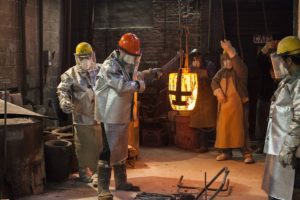Iron is one of the most abundant elements in the earth’s crust and core, which also explains why it is used so frequently around us. Iron is extracted from iron ore, which are just rocks and minerals that contain high amount of iron so that it can be extracted commercially. The iron is found in the form of magnetite, hematite, goethite, limonite, or siderite. Iron ores can be of varied colour, including rust red, deep purple, bright yellow and dark grey.
Interestingly, although iron is one of the most abundant elements in the earth’s crust, metallic iron is very rare and mostly came from meteorites. Hence, what it is iron pride that we actually use to extract iron. Iron ore suppliers in India use different methods to mine for iron, but these are mostly mined from massive hematite, magnetite, pisolitic ironstone deposits and titanomagnetite.
Iron is allotropic in nature. It means that it exists in various forms. It is very malleable and can easily be shaped with just a hammer. The biggest drawback of iron, however, is its propensity for rusting. When exposes to air and water, the metal surface will start to rust. For practical applications, iron will usually be used as part of an alloy where it is mixed with another metal to form a new material. For instance, iron and carbon form steel and cast iron.
By itself both iron and carbon have properties that does not give them very high functionality. But their alloys do not have any of these drawbacks, instead the alloys combine their advantages. This makes alloys like cast iron and steel highly useful in a wide variety of places. The versatility of these alloys makes them highly useful in metallurgy and this also explains the high demand for iron.
Iron Processing
Iron processing refers to the process by which iron ore suppliers in India convert the ore into desired products. The objective here is to extract the iron from its oxide (since it is iron oxide that is usually mined). The methods used for this include blast furnace, direct reduction and smelting reduction. The blast furnace is the most common among these.
Blast Furnace
A type of metallurgical furnace, a blast furnace uses the smelting process to extract industrial iron. This is the most common method of extracting pig iron. In the furnace a mixture of iron ore, flux and fuel is supplied into the top, while hot air is ‘blasted’ from the lower side. The air supplied is above the atmospheric pressure. The air is forced into furnace through a pipe. As the ore mix falls downward, it reacts with the hot air. This results in molten metal, which is collected at the bottom, while the fuel gases blow to of the top.
The earliest blast furnaces existed in China, but today they are found everywhere in the world. Today we have large steel corporations that run some of the largest blast furnaces as well as small factories that use the blast furnace to make pig iron or cast iron. Although blast irons are wuite cheap to run, they do require a large space.
Direct Reduction
In this method iron is extracted from its ore without bringing it to its melting point. Direct reduction is not suitable where the iron content in the ore is low as some impurities are left behind and have to be removed separately. So, it is only used for high grade ores with at least 66% iron concentrate. The results in direct reduction is not of a very high quality. It also requires fair bit of fuel. Like the blast furnace, this process is also carried out in a similar structure with the cooled metal collecting at the bottom.
Smelting Reduction
Smelting reduction is designed to improve on the functioning of a blast furnace, especially removing drawbacks like massive scale of operation, dependence on coal and resulting pollution. In smelting reduction, the iron is extracted in a two step process, which involves two separate processors. Raw material is fed into a reduction shaft. It is then reduced by counterflow process. The ‘reduced’ ore is then fed into a melter gasifier. This is where more metal reduction takes place. The advantage for iron ore suppliers in India lies in the wider range of coke that is used to extract iron.






